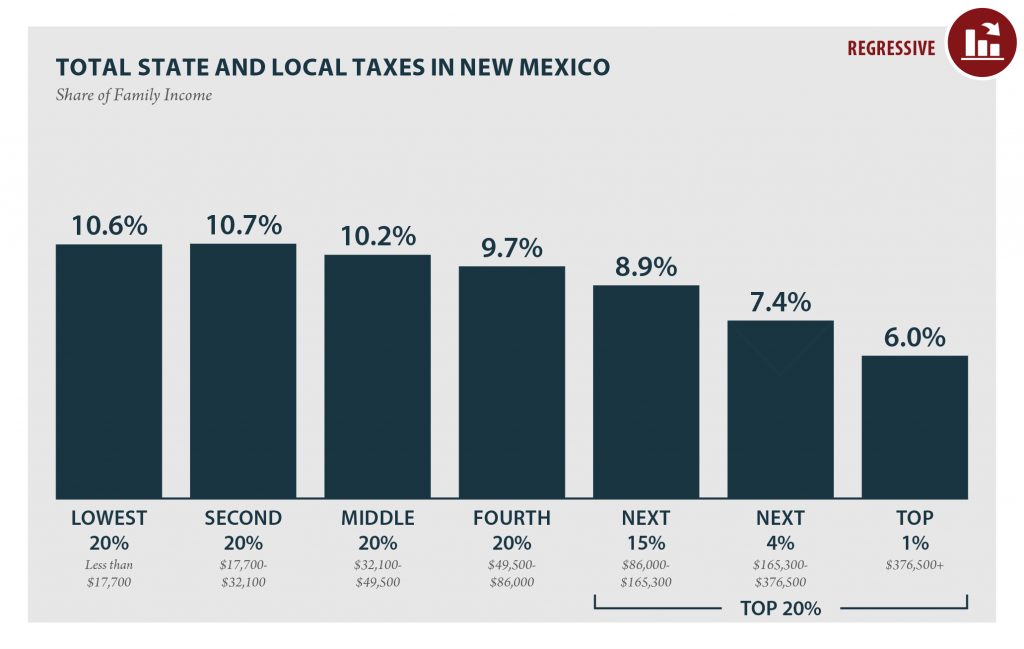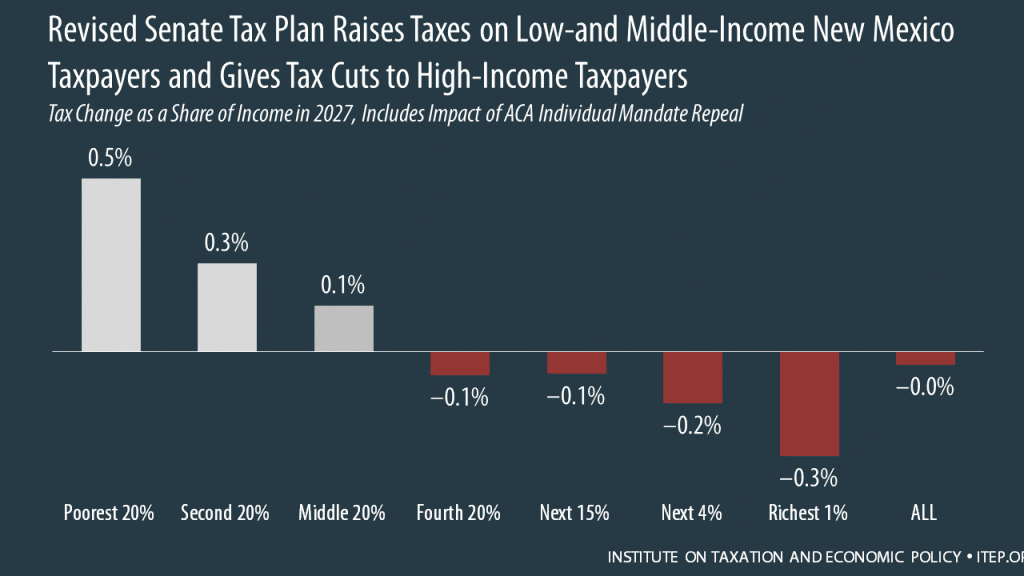
New Mexico
ITEP’s Carl Davis: Pyramids, Cascades, and the Taxation of Business Inputs
August 26, 2024
ITEP Research Director Carl Davis gave this presentation to the New Mexico Revenue Stabilization and Tax Policy Committee on August 23, 2024. View the slides here.

These forward-thinking states are demonstrating the wide variety of options for policymakers who want to raise more from the wealthiest people, rein in corporate tax avoidance, create fair tax codes and build strong communities.

While many state lawmakers have spent the past few years debating deep and damaging tax cuts that disproportionately help the rich, more forward-thinking lawmakers have improved tax equity by raising new revenue from the well-off and creating or expanding refundable tax credits for low- and moderate-income families.
New Mexico Making Tremendous Progress Making Taxes Less Regressive
January 24, 2024 • By Carl Davis

Recent tax reforms have helped to bring greater balance to New Mexico's tax code. A new in-depth look at taxes in all 50 states finds New Mexico is an emerging leader, though there’s still plenty of room for improvement.
New Mexico Taxation and Revenue Department: New Mexico Among Top 10 for Tax Equity
January 15, 2024
New Mexico is now among the top 10 states for most equitable tax structures thanks mostly to changes signed into law by Gov. Michelle Lujan Grisham over the past five years, according to a new report by the Institute on Taxation and Economic Policy (ITEP). Read more.
New Mexico: Who Pays? 7th Edition
January 9, 2024 • By ITEP Staff

New Mexico Download PDF All figures and charts show 2024 tax law in New Mexico, presented at 2023 income levels. Senior taxpayers are excluded for reasons detailed in the methodology. Our analysis includes nearly all (99.6 percent) state and local tax revenue collected in New Mexico. As seen in Appendix D, recent tax policy changes […]
ITEP’s Carl Davis: Who Pays New Mexico Taxes?
October 22, 2023
ITEP Research Director Carl Davis gave a presentation on New Mexico’s tax system to that state’s Revenue Stabilization and Tax Policy Committee on October 19, 2023. Click here for the slide deck.
A Better Alternative: New Mexico Prioritizes Targeted, Temporary Tax Cuts
March 9, 2022 • By Marco Guzman

New Mexico stands in stark contrast to the many examples of poorly targeted tax-cut proposals currently being considered around the country.
New Mexico Voices for Children: Essential But Excluded
April 30, 2020
Immigrants pay taxes and are important contributors to New Mexico’s economy. Nationwide, immigrants pay hundreds of billions of dollars in federal, state, and local income and other taxes. New Mexico immigrants – both legal residents and those who are undocumented – contribute more than $996 million in federal, state, and local taxes that help support […]
New Mexico Voices for Children: Expanding New Mexico’s Best Anti-Poverty Program
January 28, 2020
The Working Families Tax Credit (WFTC) is New Mexico’s equivalent of the federal Earned Income Tax Credit (EITC). The WFTC’s eligibility levels and credit amounts are based directly on the EITC, and like most states, the amount is a set percentage of the federal EITC. These tax credits reduce poverty, improve outcomes for children, and […]
KRWG: Analysis: 70% of NM Families With Children Will See State Income Tax Cut
October 16, 2019
Commentary: Most New Mexico families with children – 70% – will get a break on their state personal income taxes when they file their 2019 tax returns, thanks to legislation enacted in April by the state Legislature and Governor Michelle Lujan Grisham. That’s according to an analysis by the Washington, DC-based Institute on Taxation and […]
Many States Move Toward Higher Taxes on the Rich; Lower Taxes on Poor People
July 18, 2019 • By Meg Wiehe

Several states this year proposed or enacted tax policies that would require high-income households and/or businesses to pay more in taxes. After years of policymaking that slashed taxes for wealthy households and deprived states of revenue to adequately fund public services, this is a necessary and welcome reversal.
Time to restore fairness to the personal income tax and break the boom-or-bust cycle
January 22, 2019
Our citizen legislators have lots of choices to make when they meet for the annual legislative session every January – how to prioritize spending on public services like education, health care and public safety, which laws to enact, and whether to make changes to our state’s tax code.
New Mexico Voices for Children: The Cliff Effect: One Step Forward, Two Steps Back
November 29, 2018
This report focuses on the cliff effect that occurs with the loss of child care assistance for New Mexico families. Losing child care assistance is especially detrimental to families because the cost of child care is so high. High-quality child care costs more than tuition and fees at New Mexico’s 4-year public universities, so it is an expense that even middle-income families struggle to meet. This report looks at the intensity of the child care cliff effect in New Mexico, as well as problems with income eligibility ceilings and co-pays, and offers policy solutions to these problems.
New Mexico Voices for Children: The Next Governor Should Improve Our Tax System and Increase Wages
November 2, 2018
When it comes to fairness, New Mexico’s tax system is backwards. Those who earn the smallest incomes pay the highest rates in state and local taxes, according to a new report from the Institute on Taxation and Economic Policy. The responsibility for taxes should not fall hardest on those with the least ability to pay, but it does. There are several ways we can make our tax system fairer.
KRWG: Lowest-Income Taxpayers in NM Pay 1.8 Times the Tax Rate Paid by the Richest New Mexicans
October 18, 2018
Commentary: A new study released by the Institute on Taxation and Economic Policy (ITEP) finds that the lowest-income New Mexicans pay a state and local tax rate that is almost double what the state’s wealthiest residents pay as a share of their income.
New Mexico Voices for Children: New Analysis: Lowest-Income Taxpayers in NM Pay 1.8 Times the Tax Rate Paid by the Richest New Mexicans
October 17, 2018
“Taxes are the way we accomplish great things for our state – build our schools and infrastructure, provide health care and public safety, and more,” said James Jimenez, executive director of New Mexico Voices for Children, which partnered with ITEP on the report release. “These systems and services underpin our economy and improve our quality of life. We all need to do our part to support them, but our current state tax system ensures that those who can afford to pay the most actually pay the least.”
Public News Service: Report: NM Tax Overhaul Would Benefit Kids, Families
October 17, 2018
Regressive tax systems hurt children and families, according to a new report from the Institute on Taxation and Economic Policy - and by that standard, it says New Mexico has the 19th-worst tax system in the United States. The study showed that as a share of their income, the lowest-income New Mexicans are paying state and local tax rates almost double those of the state's wealthiest residents.
New Mexico: Who Pays? 6th Edition
October 17, 2018 • By ITEP Staff

NEW MEXICO Read as PDF NEW MEXICO STATE AND LOCAL TAXES Taxes as Share of Family Income Top 20% Income Group Lowest 20% Second 20% Middle 20% Fourth 20% Next 15% Next 4% Top 1% Income Range Less than $17,700 $17,700 to $32,100 $32,100 to $49,500 $49,500 to $86,000 $86,000 to $165,300 $165,300 to $376,500 […]
Tax Cuts 2.0 – New Mexico
September 26, 2018 • By ITEP Staff
The $2 trillion 2017 Tax Cuts and Jobs Act (TCJA) includes several provisions set to expire at the end of 2025. Now, GOP leaders have introduced a bill informally called “Tax Cuts 2.0” or “Tax Reform 2.0,” which would make the temporary provisions permanent. And they falsely claim that making these provisions permanent will benefit […]
New Mexico Voices for Children: Celebrate Democracy- It’s Tax Day!
April 17, 2018
While it’s easy to tick off a list of the things we enjoy that are paid for out of our taxes, paying taxes is really a moral duty that we all participate in. It is a contract that we honor collectively because it’s the way we invest in our communities. In fact, some research shows that Americans […]
How the Final GOP-Trump Tax Bill Would Affect New Mexico Residents’ Federal Taxes
December 16, 2017 • By ITEP Staff
The final tax bill that Republicans in Congress are poised to approve would provide most of its benefits to high-income households and foreign investors while raising taxes on many low- and middle-income Americans. The bill would go into effect in 2018 but the provisions directly affecting families and individuals would all expire after 2025, with […]
How the House and Senate Tax Bills Would Affect New Mexico Residents’ Federal Taxes
December 6, 2017 • By ITEP Staff

The House passed its “Tax Cuts and Jobs Act” November 16th and the Senate passed its version December 2nd. Both bills would raise taxes on many low- and middle-income families in every state and provide the wealthiest Americans and foreign investors substantial tax cuts, while adding more than $1.4 trillion to the deficit over ten years. The graph below shows that both bills are skewed to the richest 1 percent of New Mexico residents.
How the Revised Senate Tax Bill Would Affect New Mexico Residents’ Federal Taxes
November 14, 2017 • By ITEP Staff

The Senate tax bill released last week would raise taxes on some families while bestowing immense benefits on wealthy Americans and foreign investors. In New Mexico, 37 percent of the federal tax cuts would go to the richest 5 percent of residents, and 7 percent of households would face a tax increase, once the bill is fully implemented.
How the House Tax Proposal Would Affect New Mexico Residents’ Federal Taxes
November 6, 2017 • By ITEP Staff

The Tax Cuts and Jobs Act, which was introduced on November 2 in the House of Representatives, includes some provisions that raise taxes and some that cut taxes, so the net effect for any particular family’s federal tax bill depends on their situation. Some of the provisions that benefit the middle class — like lower tax rates, an increased standard deduction, and a $300 tax credit for each adult in a household — are designed to expire or become less generous over time. Some of the provisions that benefit the wealthy, such as the reduction and eventual repeal of the estate…
